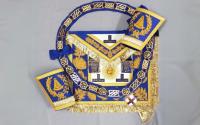The role of a Grand Master
05 March 24
The entry of a Grand Master into Grand Lodge or any lodge often sparks curiosity as to what is a Grand Master and what does he do.
There were only loose formations of lodges until the creation of the Grand Lodge of England and the need was recognised for a controlling body and a leader.
Antony Sayers was the first elected Grand Master of the Grand Lodge of England, established in 1717 which was afterwards known as the Moderns, and which joined with the Antients in 1813.
The Grand Master is the chief presiding officer of the Symbolic Degrees in a jurisdiction, presides over the Grand Lodge and has the right not only to be present, but also to preside in every lodge, with the WM on his left, and to order his Grand Wardens to attend him and act as Wardens in that particular lodge.
He has the right to visit lodges as often as he pleases, or, if unable to do so, he may send his Grand Officers to act for him. When he visits a lodge, as the ruler of the Order he must be received with the greatest respect and the WM should always offer him the Chair, which the Grand Master may or may not accept.
Among the many and varied duties of a Grand Master is the granting of Dispensations for the formation of new lodges, to ballot for and initiate a candidate on the same night, to prohibit an initiation or installation, to determine the interval between degrees, regalia to be worn, licence for a Lodge of Instruction, grants of relief, the Quarterly Communication, appointment of representatives at Installations and the appointment of his Deputy and Assistant Grand Masters. By delegation RGCs are permitted to issue limited Dispensations.
He is expected to attend the meetings of the various Boards and Committees of Grand Lodge, be constantly aware of the commitments of Grand Lodge and its finances, to attend other Grand Installations where possible and to wear the Grand Master’s regalia when appropriate.

The regalia consists of an Apron, Chain, Jewel and Gauntlets. When the United Grand Lodge of NSW was established in 1888, the regalia adopted for the Grand Master was practically the same as that used by the United Grand Lodge of England except for the provision of a distinctive shield from which the jewel is hung on the Chain and a NSW monogram replacing the English model.
The Apron is of white lambskin, lined with garter blue and edged with garter blue ribbon, having gold braid and fringes, two tassels in gold and three gold levels. The garter blue was apparently chosen as the Grand
Lodge colour after King George I changed the colour of the Order of the Garter from light blue to the darker blue. It is ornamented with pomegranates, lotuses and seven eared wheat with the blazing sun in the centre.
The Chain is of gold and is mounted on garter blue ribbon with shoulder bows on each side. The links of the Chain are connected by knots composed of nine five-point stars and four monograms of the UGL of NSW & ACT. The Chain has been a distinguishing mark of office and dignity for centuries.
The Jewel is worn suspended from the Chain beneath a white enamelled shield bearing part of the heraldic arms of NSW. It consists of the Compasses extended to 45 degrees and a gold plate on which is superimposed the All-Seeing Eye in a circle.
The Gauntlets were originally part of the gloves and do not have any special symbolical significance. They became part of the prescribed regalia in 1884 and carry the badge of office in gold.
Such is the role and regalia of a Grand Master.
Photos courtesy of RRJ Products the manufacturer of the attached regalia.
As appeared in the winter of 2011 Freemason.


